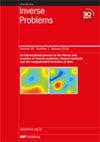Solving inverse scattering problems via reduced-order model embedding procedures
IF 2
2区 数学
Q1 MATHEMATICS, APPLIED
引用次数: 0
Abstract
We present a reduced-order model (ROM) methodology for inverse scattering problems in which the ROMs are data-driven, i.e. they are constructed directly from data gathered by sensors. Moreover, the entries of the ROM contain localised information about the coefficients of the wave equation. We solve the inverse problem by embedding the ROM in physical space. Such an approach is also followed in the theory of ‘optimal grids,’ where the ROMs are interpreted as two-point finite-difference discretisations of an underlying set of equations of a first-order continuous system on this special grid. Here, we extend this line of work to wave equations and introduce a new embedding technique, which we call通过降阶模型嵌入程序解决反向散射问题
我们提出了一种用于反向散射问题的降阶模型(ROM)方法,其中的 ROM 由数据驱动,即直接从传感器收集的数据中构建。此外,ROM 的条目包含波方程系数的局部信息。我们通过将 ROM 嵌入物理空间来解决逆问题。这种方法在 "最优网格 "理论中也有应用,在这种特殊网格上,ROM 被解释为一阶连续系统底层方程组的两点有限差分离散。在这里,我们将这一研究思路扩展到波方程,并引入了一种新的嵌入技术,我们称之为 Krein 嵌入,因为它受到了 Krein 在弦振动方面的开创性工作的启发。在这种嵌入方法中,自适应网格和介质参数集可以直接从 ROM 中提取,而且我们证明可以避免最优网格嵌入的一些限制。此外,我们还展示了 Krein 嵌入与经典最优网格嵌入之间的联系,以及最优网格的收敛结果可以扩展到这种新颖的嵌入方法。最后,我们还简要讨论了开放域的 Krein 嵌入,即在一个方向上延伸到无穷大的半无限域。
本文章由计算机程序翻译,如有差异,请以英文原文为准。
求助全文
约1分钟内获得全文
求助全文
来源期刊

Inverse Problems
数学-物理:数学物理
CiteScore
4.40
自引率
14.30%
发文量
115
审稿时长
2.3 months
期刊介绍:
An interdisciplinary journal combining mathematical and experimental papers on inverse problems with theoretical, numerical and practical approaches to their solution.
As well as applied mathematicians, physical scientists and engineers, the readership includes those working in geophysics, radar, optics, biology, acoustics, communication theory, signal processing and imaging, among others.
The emphasis is on publishing original contributions to methods of solving mathematical, physical and applied problems. To be publishable in this journal, papers must meet the highest standards of scientific quality, contain significant and original new science and should present substantial advancement in the field. Due to the broad scope of the journal, we require that authors provide sufficient introductory material to appeal to the wide readership and that articles which are not explicitly applied include a discussion of possible applications.
 求助内容:
求助内容: 应助结果提醒方式:
应助结果提醒方式:


